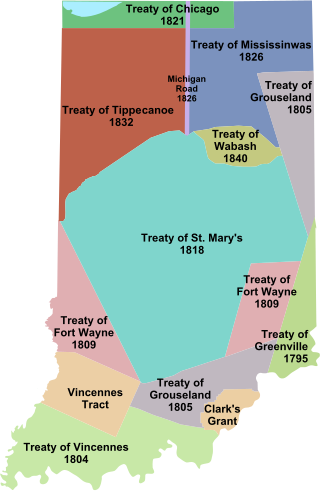Treaty
On October 26, 1832, the United States government entered negotiations with the Native American tribes of north-western Indiana seeking to purchase their land for white settlement. The United States was represented by three commissioners, former Governor of Indiana Jonathan Jennings, John Wesley Davis and Marks Crume. The United States had already purchased the Miami claim to the region in a previous treaty, and the Pottawatomie were the only natives who still held a claim in the region. [2] The land purchased was most of the northwestern part of the state of Indiana. It was recorded in the treaty as:
beginning at a point on Lake Michigan, where the line dividing the States of Indiana and Illinois intersects the saline thence with the margin of said Lake, to the intersection of the southern boundary of a cession made by the Pottawatomie, at the treaty of the Wabash, of eighteen hundred and twenty-six; thence east, to the northwest corner of the cession made by the treaty of St. Joseph's, in eighteen hundred and twenty-eight; thence south ten miles; thence with the Indian boundary line to the Michigan road; thence south with said road to the northern boundary line, air designated in the treaty of eighteen hundred and twenty-six, with the Pottawatomie; thence west with the Indian boundary line to the river Tippecanoe; thence with the Indian boundary line, as established by the treaty of eighteen hundred and eighteen, at St. Mary's to the line dividing the States of Indiana and Illinois; and thence north, with the line dividing the said States, to the place of beginning. [2]
The treaty provided for establishing a reserve for the Pottawatomie along the Yellow River, and to build a mill for them on that reservation. [3] In exchange for the land, the Potawatomi tribe was granted an annual payment of $20,000 (USD) for a term of twenty years. Upon signing the treaty, the tribe was also granted $100,000 in goods, and a lump sum payment of $62,412 for payment of debts owed by the Potawatomi. The government also offered the tribes assistance in moving to new lands in Indian Territory, and providing farming implements to assist them in cultivating the land they would move to. [2]
The native tribes agreed, and the following tribal leaders signed the treaty with an X mark: Louison, Che-ehaw-eose, Banack, Man-o-quett, Kin-kosh, Pee-shee-Nvaw-no, Menominee, Mis-sah-kaw-way, Kee-waw-nay, Sen-bo-go, Che-quaw-ma-eaw-co, Muak-kose, Ah-you-way, Po-kah-kause, So-po tie, Newark, Che-man, No-taw-kah, Nas-waw-kee, Pec-pin-a-paw, Ma-ehe-saw, O-kitch-ehee, Pee-pish-kah, conl-mo-yo, Chiek-kose, Mis-qua buck, Mo-tie-ah, Muck-ka-tah-mo-tvay, Mah-qusw-shee, O-sheh-weh, Mah-zick, Queh-kah-pah, Quash-quaw, Louisor Perish, Pam-bo-go, Bee-ya w-yo, Pah-ciss, Mauck-eo-pavv-waw, Mis-sah-qua, Kawk, Miee-kiss, Shaw-bo, Aub-be-naub-bee, Mau-maut-wah, O-ka-mause, Pash-ee-po, We-wiss-lai, Ash-kom, and Waw-zee-o-nes. [2]

The Battle of Tippecanoe was fought on November 7, 1811, in Battle Ground, Indiana, between American forces led by then Governor William Henry Harrison of the Indiana Territory and tribal forces associated with Shawnee leader Tecumseh and his brother Tenskwatawa, leaders of a confederacy of various tribes who opposed European-American settlement of the American frontier. As tensions and violence increased, Governor Harrison marched with an army of about 1,000 men to attack the confederacy's headquarters at Prophetstown, near the confluence of the Tippecanoe River and the Wabash River.

The Potawatomi, also spelled Pottawatomi and Pottawatomie, are a Native American people of the Great Plains, upper Mississippi River, and western Great Lakes region. They traditionally speak the Potawatomi language, a member of the Algonquian family. The Potawatomi call themselves Neshnabé, a cognate of the word Anishinaabe. The Potawatomi are part of a long-term alliance, called the Council of Three Fires, with the Ojibwe and Odawa (Ottawa). In the Council of Three Fires, the Potawatomi are considered the "youngest brother". Their people are referred to in this context as Bodéwadmi, a name that means "keepers of the fire" and refers to the council fire of three peoples.

Watseka or Watchekee was a Potawatomi Native American woman, born in Illinois, and named for the heroine of a Potawatomi legend. Her uncle was Tamin, the chief of the Kankakee Potawatomi Indians.

Tecumseh's War or Tecumseh's Rebellion was a conflict between the United States and Tecumseh's confederacy, led by the Shawnee leader Tecumseh in the Indiana Territory. Although the war is often considered to have climaxed with William Henry Harrison's victory at the Battle of Tippecanoe in 1811, Tecumseh's War essentially continued into the War of 1812 and is frequently considered a part of that larger struggle. The war lasted for two more years, until 1813, when Tecumseh and his second-in-command, Roundhead, died fighting Harrison's Army of the Northwest at the Battle of Moraviantown in Upper Canada, near present-day Chatham, Ontario, and his confederacy disintegrated. Tecumseh's War is viewed by some academic historians as the final conflict of a longer-term military struggle for control of the Great Lakes region of North America, encompassing a number of wars over several generations, referred to as the Sixty Years' War.
Match-E-Be-Nash-She-Wish was a hereditary chief of a Potawatomi Indian group in what is now Michigan. The Potawatomi are one of the peoples of the Council of Three Fires; the others are the Odawa and the Ojibwe, all Algonquian-language speakers.

The Treaty of St. Mary's may refer to one of six treaties concluded in fall of 1818 between the United States and Natives of central Indiana regarding purchase of Native land. The treaties were

The Treaty of La Pointe may refer to either of two treaties made and signed in La Pointe, Wisconsin between the United States and the Ojibwe (Chippewa) Native American peoples. In addition, the Isle Royale Agreement, an adhesion to the first Treaty of La Pointe, was made at La Pointe.

John Tipton was from Tennessee and became a farmer in Indiana; an officer in the 1811 Battle of Tippecanoe, and veteran officer of the War of 1812, in which he reached the rank of Brigadier General; and politician. He was elected to the Indiana General Assembly in 1819, and in 1831 as US Senator from the state of Indiana, serving until 1838. He was appointed as US Indian Agent and was selected to lead the militia in removing Menominee's band of Potawatomie in 1838; they were relocated to Kansas, Indian Territory.

Waubonsie was a leader of the Potawatomi Native American people. His name has been spelled in a variety of ways, including Wabaunsee, Wah-bahn-se, Waubonsee, Waabaanizii in the contemporary Ojibwe language, and Wabanzi in the contemporary Potawatomi language.

The Potawatomi Trail of Death was the forced removal by militia in 1838 of about 859 members of the Potawatomi nation from Indiana to reservation lands in what is now eastern Kansas.

George Winter was an English-born landscape and portrait artist who immigrated to the United States in 1830 and became an American citizen in northern Indiana's Wabash River valley. Winter was one of Indiana's first professional artists. In addition, he is considered the state's most significant painter of the first half of the nineteenth century. Winter is especially noted for his sketches, watercolors, and oil portraits that provide a visual record of the Potawatomi and Miami people in northern Indiana from 1837 to the 1840s, as well as other figures drawn from his firsthand observations on the American frontier.
The Little Arkansas Treaty was a set of treaties signed between the United States of America and the Kiowa, Comanche, Plains Apache, Southern Cheyenne, and Southern Arapaho at Little Arkansas River, Kansas in October 1865. On October 14 and 18, 1865 the United States and all of the major Plains Indians Tribes signed a treaty on the Little Arkansas River, which became known as the Little Arkansas Treaty. It is notable in that it lasted less than two years, the reservations it created for the Plains Indians were never created at all, and were reduced by 90% eighteen months later in the Medicine Lodge Treaty.

Indian removals in Indiana followed a series of the land cession treaties made between 1795 and 1846 that led to the removal of most of the native tribes from Indiana. Some of the removals occurred prior to 1830, but most took place between 1830 and 1846. The Lenape (Delaware), Piankashaw, Kickapoo, Wea, and Shawnee were removed in the 1820s and 1830s, but the Potawatomi and Miami removals in the 1830s and 1840s were more gradual and incomplete, and not all of Indiana's Native Americans voluntarily left the state. The most well-known resistance effort in Indiana was the forced removal of Chief Menominee and his Yellow River band of Potawatomi in what became known as the Potawatomi Trail of Death in 1838, in which 859 Potawatomi were removed to Kansas and at least forty died on the journey west. The Miami were the last to be removed from Indiana, but tribal leaders delayed the process until 1846. Many of the Miami were permitted to remain on land allotments guaranteed to them under the Treaty of St. Mary's (1818) and subsequent treaties.
Tecumseh's confederacy was a confederation of Native Americans in the Great Lakes region of North America which formed during the early 19th century around the teaching of Shawnee leader Tenskwatawa. The confederation grew over several years and came to include several thousand Native American warriors. Shawnee leader Tecumseh, the brother of Tenskwatawa, became the leader of the confederation as early as 1808. Together, they worked to unite the various tribes against colonizers from the United States who had been crossing the Appalachian Mountains and occupying their traditional homelands.

Menominee was a Potawatomi chief and religious leader whose village on reservation lands at Twin Lakes, 5 miles (8.0 km) southwest of Plymouth in present-day Marshall County, Indiana, became the gathering place for the Potawatomi who refused to remove from their Indiana reservation lands in 1838. Their primary settlements were at present day Myers Lake and Cook Lake. Although Menominee's name and mark appear on several land cession treaties, including the Treaty of St. Mary's (1818), the Treaty of Mississinewas (1826), the Treaty of Tippecanoe (1832), and a treaty signed on December 16, 1834, he and other Potawatomi refused to take part in subsequent land cession negotiations, including the Treaty of Yellow River (1836), that directly led to the forced removal of Menominee's band from Indiana in 1838.
The Treaty of Turkey Creek Prairie, unofficially called the Treaty of the Potawatomi, was signed March 26, 1836 between Mes-quaw-buck, a chief of the Potawatomi tribe of Native Americans, and the United States of America, represented by Abel C. Pepper. The accord originally contained six articles, with Article 6 stricken out by the Senate. The treaty ceded four sections of land on the Tippecanoe River, effective October 27, 1832. The United States paid the Chief and his band $2,560 "in specie at the next payment of annuity" once the treaty was ratified.

The Treaty of Prairie du Chien may refer to any of several treaties made and signed in Prairie du Chien, Wisconsin between the United States, representatives from the Sioux, Sac and Fox, Menominee, Iowa, Ho-Chunk and the Anishinaabeg Native American peoples.
Between 1851 and 1852, the United States Army forced California's tribes to sign 18 treaties that relinquished each tribe's rights to their traditional lands in exchange for reservations. Due to pressure from California representatives, the Senate repudiated the treaties and ordered them to remain secret. In 1896 the Bureau of American Ethnology report on major native American Indian interactions with the United States Government was the first time the treaties were made public. The report, Indian Land Cessions in the United States (book), compiled by Charles C. Royce, includes the 18 lost treaties between the state's tribes and a map of the reservations. Below is the California segment of the report listing the treaties. The full report covered all 48 states' tribal interactions nationwide with the U.S. government.

The 1833 Treaty of Chicago was an agreement between the United States government and the Chippewa, Odawa, and Potawatomi tribes. It required them to cede to the United States government their 5,000,000 acres (2,000,000 ha) of land in Illinois, the Wisconsin Territory, and the Michigan Territory and to move west of the Mississippi River. In return, the tribes were given promises of various cash payments and tracts of land west of the Mississippi River. The treaty was one of the removal treaties to come after the passage of the Indian Removal Act. It was the second treaty referred to as the "Treaty of Chicago," after the 1821 Treaty of Chicago.
















